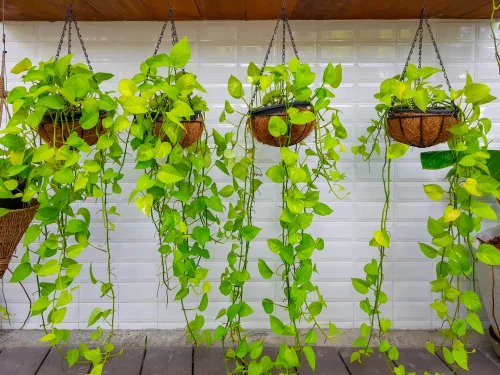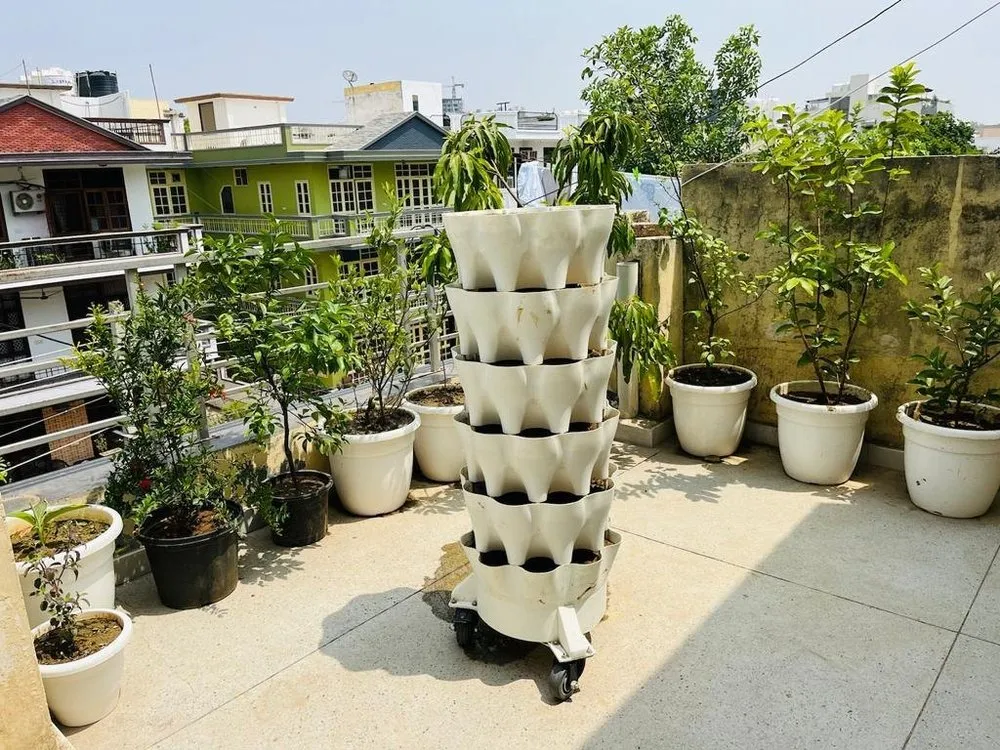Table of Content
Whether you possess a petite balcony, a compact patio, or merely a slim stretch of space, incorporating the charm of greenery and lively plants is possible through the establishment of a vertical garden. Commonly referred to as green walls or living walls, vertical gardens present an excellent remedy for city residents and those with restricted outdoor areas. Beyond enhancing visual allure, they provide various advantages like enhanced air quality, noise mitigation, and fostering biodiversity. This article will delve into systematic approaches, expert advice, and imaginative concepts to transform your confined space into a flourishing and dynamic vertical garden.
Steps for creating a vertical garden in small spaces
Let’s explore the process of creating a vertical garden in small spaces:
Step 1: Assess your space
Before you start, assess your small space carefully. Consider factors such as sunlight exposure, wind patterns and the type of surface you’ll be attaching the garden to. Understanding these elements will help you choose the right plants and create a thriving environment.
Also Read: 15 Best Vastu Plants For Home Which Brings in Happiness & Wealth
Step 2: Choose the right plants
Selecting the right plants is crucial for the success of your vertical garden. Opt for plants that are well-suited to your space’s light conditions and climate. Some popular choices for vertical gardens include ferns, succulents, herbs and trailing vines like pothos and ivy.
Step 3: Determine the vertical garden structure
There are various types of vertical garden structures to choose from, depending on your space and budget. Some common options include:
- Vertical planters: These stackable planters allow you to grow plants vertically with minimal space requirements.

- Wall-mounted pots: Attach pots or containers to the wall to create a stunning living wall effect.

- Hanging planters: Hang pots from the ceiling or railings to maximise vertical space.

- Pocket planters: Fabric pockets attached to a wall or fence are great for growing herbs and small plants.
Step 4: Prepare the growing medium
The right growing medium is essential for providing nutrients and support to your plants. Consider using a lightweight potting mix that retains moisture well while allowing adequate drainage. Adding organic compost can further enhance the soil’s fertility.
Also Read: Vastu Tips to Place Money Plant In your Bedroom - Vastu Home Tips
Step 5: Install an irrigation system
Vertical gardens require a well-thought-out irrigation system to ensure proper watering. Drip irrigation or self-watering systems can help conserve water and ensure each plant receives the right amount of moisture.
Step 6: Arrange the plants creatively
When arranging your plants, think about their growth habits and aesthetics. Place taller plants towards the back and cascading ones towards the front. Experiment with different colours and textures to create an eye-catching display.
Step 7: Regular maintenance
To keep your vertical garden flourishing, regular maintenance is necessary. Prune the plants as needed, remove any dead or yellowing leaves and inspect for pests. Don’t forget to fertilise the plants at the appropriate intervals. Create a maintenance calendar to stay on top of the care your vertical garden needs throughout the year. Different seasons require different attention, and a well-planned schedule can ensure your garden thrives year-round.
Also Read: 10 Reasons You Should Have a Tulsi Plant in Your Home
Helpful tips to create a vertical garden
Keeping these tips in mind can help you create and maintain a beautiful vertical garden at home.
Vertical garden DIY projects
For those with a penchant for DIY projects, creating your own vertical garden structure can be a fulfilling and cost-effective option. You can repurpose old wooden pallets, gutters or even shoe organisers to make unique vertical planters.
Enhance with vertical garden accessories
Accessorise your vertical garden with creative elements like fairy lights, colourful plant markers and small garden ornaments. These additions can elevate the overall look of your garden and add a personal touch.
Maintain a sustainable vertical garden
Sustainability is key when creating a vertical garden. Consider using recycled materials for your planters, harvesting rainwater for irrigation and using organic fertilisers to promote eco-friendliness.
Troubleshooting common vertical garden issues
Even with the best care, you might encounter some common issues in your vertical garden. Learn how to identify and tackle problems such as overwatering, under watering and pest infestations.
Check out success stories of small-space vertical gardens
Gather inspiration from successful vertical garden projects around the world. Read about real success stories of individuals who have transformed their small spaces into breathtaking vertical gardens. Discover their challenges, tips and experiences that can motivate and guide you in your own project. Explore different designs, themes and creative uses of space to find ideas that resonate with your vision.
Combine vertical gardens with other elements
Find out how to complement your vertical garden with other elements like hanging art pieces, wall shelves and comfortable seating arrangements. A harmonious blend of greenery and aesthetics can create a relaxing and inviting ambiance.
Vertical gardening for apartments
Apartment living doesn’t have to limit your gardening dreams. Explore specific tips and ideas for creating vertical gardens on balconies, windowsills and even indoor walls.
Vertical garden: Vastu tips
To invite positive energies into your home, adhere to the following Vastu tips for a vertical garden:
- Optimal Direction: The ideal direction for a vertical garden wall is the north, enhancing financial well-being and fostering positivity.
- Money Plants Significance: Money plants are highly recommended for vertical gardens, contributing to the influx of positive energy.
- Orientation for Public Interaction: Individuals engaged in frequent public interactions should consider installing vertical garden walls in the eastern direction.
- Plant Selection: According to Vastu Shastra, cultivating jade plants, aloe vera, and basil is advised, as they are believed to attract positive energy.
- Inauspicious Directions: Avoid constructing vertical gardens or green walls on walls facing southwest, southeast, and south directions, as these may bring unfavorable energy.
- Thorny Plant Caution: Refrain from incorporating thorny plants in vertical gardens, as they are believed to introduce negative energy into the household.
- Compound Wall Decor: Avoid placing flower plants on compound walls, following Vastu principles.
- Central Avoidance: Steer clear of installing a vertical garden wall in the center of the house, as this area is considered empty and pristine in Vastu.
Also Read: Living room indoor plants to enhance the ambiance of your home












Ans 1. Yes, you can create a vertical garden indoors. Choose plants that thrive in indoor conditions and use a wall-mounted planter or vertical stand to set up your garden.
Ans 2. Watering your vertical garden depends on the type of plants and the irrigation system you have. Drip irrigation or self-watering systems are effective ways to ensure proper watering.
Ans 3. Yes, vertical gardens are perfect for small balconies, as they utilise vertical space and don't take up much floor area.
Ans 4. Yes, certain vegetables like lettuce, tomatoes and herbs can be grown in a vertical garden. Ensure they receive enough sunlight and proper support for climbing plants.
Ans 5. In winter, plants may require less frequent watering and might need protection from frost. Move sensitive plants indoors or cover them with frost cloth during cold spells.
Ans 6. For shaded areas, choose plants like ferns, peace lilies and snake plants that thrive in low-light conditions.